trailer CITROEN DS4 2018 Owners Manual
[x] Cancel search | Manufacturer: CITROEN, Model Year: 2018, Model line: DS4, Model: CITROEN DS4 2018Pages: 296, PDF Size: 9.91 MB
Page 10 of 296
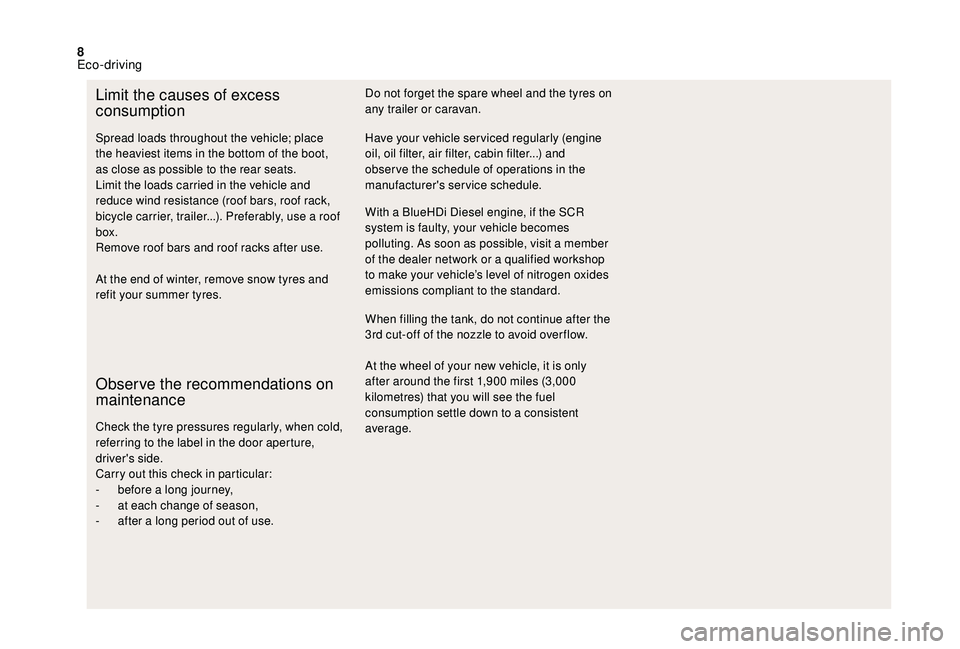
8
Limit the causes of excess
consumption
Spread loads throughout the vehicle; place
the heaviest items in the bottom of the boot,
as close as possible to the rear seats.
Limit the loads carried in the vehicle and
reduce wind resistance (roof bars, roof rack,
bicycle carrier, trailer...). Preferably, use a roof
box.
Remove roof bars and roof racks after use.
At the end of winter, remove snow tyres and
refit your summer tyres.
Observe the recommendations on
maintenance
Check the tyre pressures regularly, when cold,
referring to the label in the door aperture,
driver's side.
Carry out this check in particular:
-
b
efore a long journey,
-
a
t each change of season,
-
a
fter a long period out of use. Have your vehicle ser viced regularly (engine
oil, oil filter, air filter, cabin filter...) and
obser ve the schedule of operations in the
manufacturer's service schedule.
With a BlueHDi Diesel engine, if the SCR
system is faulty, your vehicle becomes
polluting. As soon as possible, visit a member
of the dealer network or a qualified workshop
to make your vehicle’s level of nitrogen oxides
emissions compliant to the standard.
When filling the tank, do not continue after the
3rd cut-off of the nozzle to avoid over flow.
At the wheel of your new vehicle, it is only
after around the first 1,900 miles (3,000
kilometres) that you will see the fuel
consumption settle down to a consistent
average. Do not forget the spare wheel and the tyres on
any trailer or caravan.
Eco-driving
Page 135 of 296
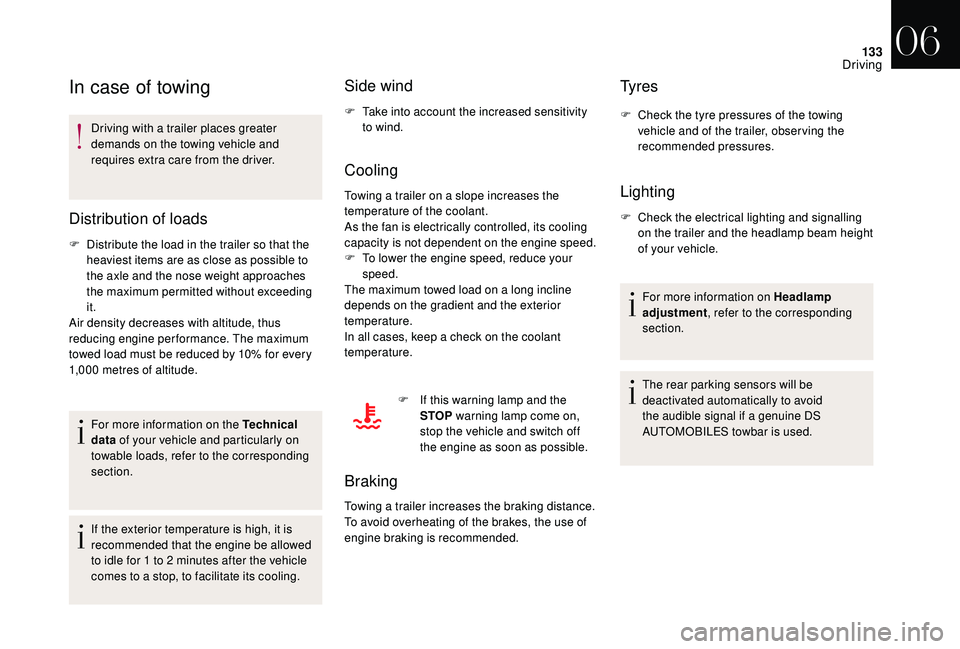
133
In case of towing
Driving with a trailer places greater
demands on the towing vehicle and
requires extra care from the driver.
Distribution of loads
F Distribute the load in the trailer so that the heaviest items are as close as possible to
the axle and the nose weight approaches
the maximum permitted without exceeding
it.
Air density decreases with altitude, thus
reducing engine performance. The maximum
towed load must be reduced by 10% for every
1,000 metres of altitude.
For more information on the Technical
data of your vehicle and particularly on
towable loads, refer to the corresponding
section.
If the exterior temperature is high, it is
recommended that the engine be allowed
to idle for 1 to 2 minutes after the vehicle
comes to a stop, to facilitate its cooling.
Side wind
F Take into account the increased sensitivity to wind.
Cooling
Towing a trailer on a slope increases the
temperature of the coolant.
As the fan is electrically controlled, its cooling
capacity is not dependent on the engine speed.
F
T
o lower the engine speed, reduce your
speed.
The maximum towed load on a long incline
depends on the gradient and the exterior
temperature.
In all cases, keep a check on the coolant
temperature.
F
I
f this warning lamp and the
STOP warning lamp come on,
stop the vehicle and switch off
the engine as soon as possible.
Braking
Towing a trailer increases the braking distance.
To avoid overheating of the brakes, the use of
engine braking is recommended.
Ty r e s
F Check the tyre pressures of the towing vehicle and of the trailer, observing the
recommended pressures.
Lighting
F Check the electrical lighting and signalling on the trailer and the headlamp beam height
of your vehicle.
For more information on Headlamp
adjustment , refer to the corresponding
section.
The rear parking sensors will be
deactivated automatically to avoid
the audible signal if a genuine DS
AUTOMOBILES towbar is used.
06
Driving
Page 142 of 296
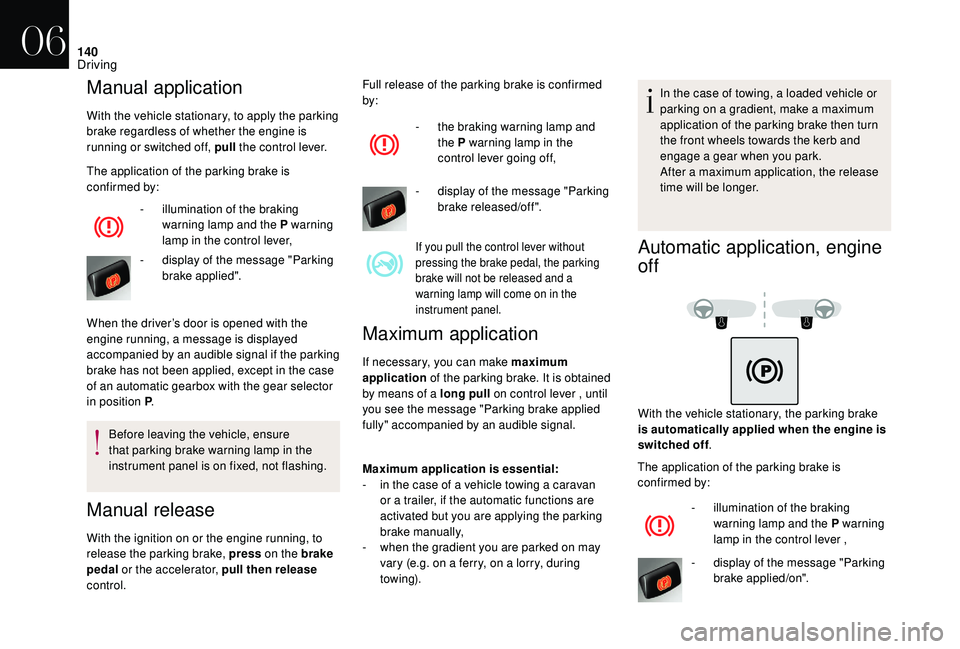
140
Manual application
With the vehicle stationary, to apply the parking
brake regardless of whether the engine is
running or switched off, pull the control lever.
The application of the parking brake is
confirmed by:
When the driver’s door is opened with the
engine running, a message is displayed
accompanied by an audible signal if the parking
brake has not been applied, except in the case
of an automatic gearbox with the gear selector
in position P .
Before leaving the vehicle, ensure
that parking brake warning lamp in the
instrument panel is on fixed, not flashing.
Manual release
With the ignition on or the engine running, to
release the parking brake, press on the brake
pedal or the accelerator, pull then release
control. Full release of the parking brake is confirmed
by:
-
d
isplay of the message "Parking
brake released/off".
If you pull the control lever without
pressing the brake pedal, the parking
brake will not be released and a
warning lamp will come on in the
instrument panel.
Maximum application
If necessary, you can make maximum
application of the parking brake. It is obtained
by means of a long pull on control lever , until
you see the message "Parking brake applied
fully" accompanied by an audible signal.
Maximum application is essential:
-
i
n the case of a vehicle towing a caravan
or a trailer, if the automatic functions are
activated but you are applying the parking
brake manually,
-
w
hen the gradient you are parked on may
vary (e.g. on a ferry, on a lorry, during
towing). In the case of towing, a loaded vehicle or
parking on a gradient, make a maximum
application of the parking brake then turn
the front wheels towards the kerb and
engage a gear when you park.
After a maximum application, the release
time will be longer.
Automatic application, engine
off
With the vehicle stationary, the parking brake
is automatically applied when the engine is
switched off
.
The application of the parking brake is
confirmed by:
-
d
isplay of the message "Parking
brake applied/on".
-
i
llumination of the braking
warning lamp and the P warning
lamp in the control lever,
-
d
isplay of the message "Parking
brake applied". -
t
he braking warning lamp and
the P warning lamp in the
control lever going off,
-
i
llumination of the braking
warning lamp and the P warning
lamp in the control lever ,
06
Driving
Page 160 of 296
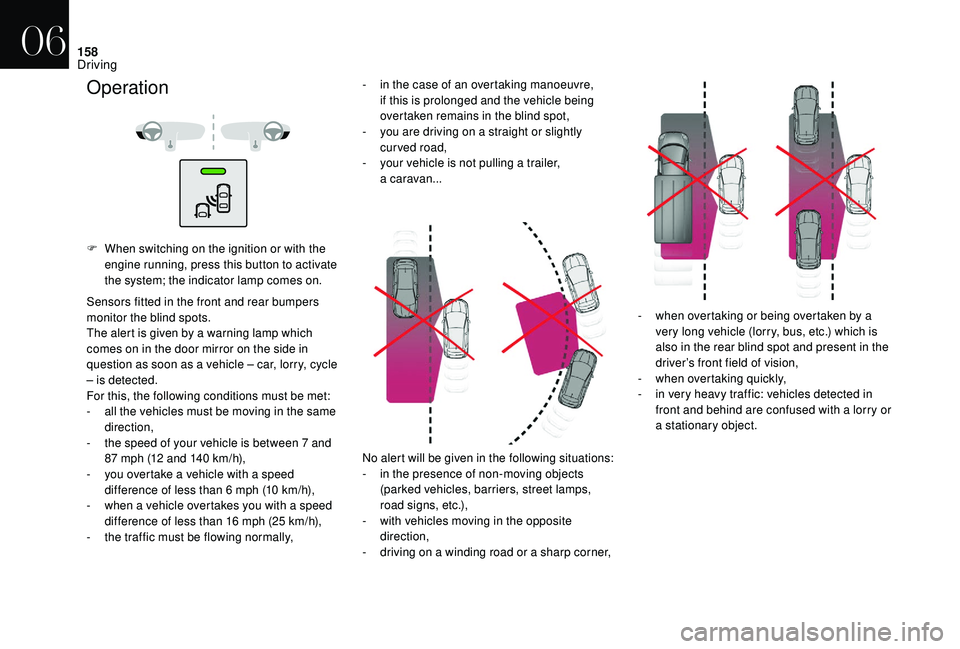
158
F When switching on the ignition or with the engine running, press this button to activate
the system; the indicator lamp comes on.
Sensors fitted in the front and rear bumpers
monitor the blind spots.
The alert is given by a warning lamp which
comes on in the door mirror on the side in
question as soon as a vehicle – car, lorry, cycle
– is detected.
For this, the following conditions must be met:
-
a
ll the vehicles must be moving in the same
direction,
-
t
he speed of your vehicle is between 7 and
87 mph (12 and 140 km/h),
-
y
ou overtake a vehicle with a speed
difference of less than 6 mph (10 km/h),
-
w
hen a vehicle overtakes you with a speed
difference of less than 16 mph (25 km/h),
-
t
he traffic must be flowing normally, No alert will be given in the following situations:
-
i
n the presence of non-moving objects
(parked vehicles, barriers, street lamps,
road signs, etc.),
-
w
ith vehicles moving in the opposite
direction,
-
d
riving on a winding road or a sharp corner,-
w
hen overtaking or being overtaken by a
very long vehicle (lorry, bus, etc.) which is
also in the rear blind spot and present in the
driver’s front field of vision,
-
w
hen overtaking quickly,
-
i
n very heavy traffic: vehicles detected in
front and behind are confused with a lorry or
a stationary object.
Operation- in the case of an overtaking manoeuvre, if this is prolonged and the vehicle being
overtaken remains in the blind spot,
-
y
ou are driving on a straight or slightly
curved road,
-
y
our vehicle is not pulling a trailer,
a
caravan...
06
Driving
Page 162 of 296

160
Rear parking sensors
The system is switched on by engaging reverse
g e a r.
This is confirmed by an audible signal.
The system is switched off when you come out
of reverse gear.
Audible assistanceVisual assistanceThis supplements the audible signal by
displaying bars in the screen which move
progressively nearer to the vehicle.
When the obstacle is very close, the "Danger"
symbol is displayed in the screen.
Front parking sensors
In addition to the rear parking sensors, the
front parking sensors are triggered when an
obstacle is detected in front and the speed of
the vehicle is still below 6 mph (10 km/h).
The front parking sensors are interrupted if
the vehicle stops for more than three seconds
in for ward gear, if no further obstacles are
detected or when the speed of the vehicle
exceeds 6 mph (10 km/h).
The sound emitted by the speaker (front or
rear) indicates whether the obstacle is in
front or behind.
Deactivation/activation of the
front and rear parking sensors
The function is deactivated by pressing this
button. The button indicator lamp comes on.
Pressing this button again reactivates the
function. The button indicator lamp goes off.
The function will be deactivated
automatically if a trailer is being towed or a
bicycle carrier is fitted (vehicle fitted with a
towbar or an approved bicycle carrier).
The proximity information is given by an
intermittent audible signal, the frequency of
which increases as the vehicle approaches the
obstacle.
The sound emitted by the speaker (right or
left) indicates the side on which the obstacle is
located.
When the distance between the vehicle and
the obstacle becomes less than approximately
thirty centimetres, the audible signal becomes
continuous.
06
Driving
Page 172 of 296

170
Very cold climate screen
(Depending on the country of sale.)
Removable protective screen which prevents
the accumulation of snow at the radiator
cooling fan.
Fitting
F Position the very cold climate screen to the front of the lower section of the front
b u m p e r.
F
P
ress around its edge to engage its fixing
clips one by one.
Removing
F Use a screwdriver as a lever to release each fixing clip.
The very cold climate screen must be
removed when:
-
t
he exterior temperature exceeds
10°C,
-
w
hen towing,
-
a
t speeds above 75 mph (120 km/h).
To w b a r
Your vehicle is primarily designed for
transporting people and luggage, but it may
also be used for towing a trailer.We recommend the use of genuine
DS AUTOMOBILES towbars and their
harnesses that have been tested and
approved from the design stage of your
vehicle, and that the fitting of the towbar
is entrusted to a dealer or a qualified
workshop.
If the towbar is not fitted by a dealer, it
must still be fitted in accordance with the
vehicle manufacturer's instructions. Driving with a trailer places greater
demands on the towing vehicle and the
driver must take particular care.
For more information on Driving advice
,
particularly when towing, refer to the
corresponding section.
Obser ve the maximum authorised towable
weight, indicated on your vehicle's
registration certificate, the manufacturer's
label as well as in the Technical data
section of this guide.
Complying with the maximum
authorised nose weight (towball)
also includes the use of accessories
(bicycle carriers, tow boxes, etc.).
The maximum authorised nose weight
does not depend on the type of device
installed, fixed or removable, with or
without a tool.
07
Practical information
Page 173 of 296
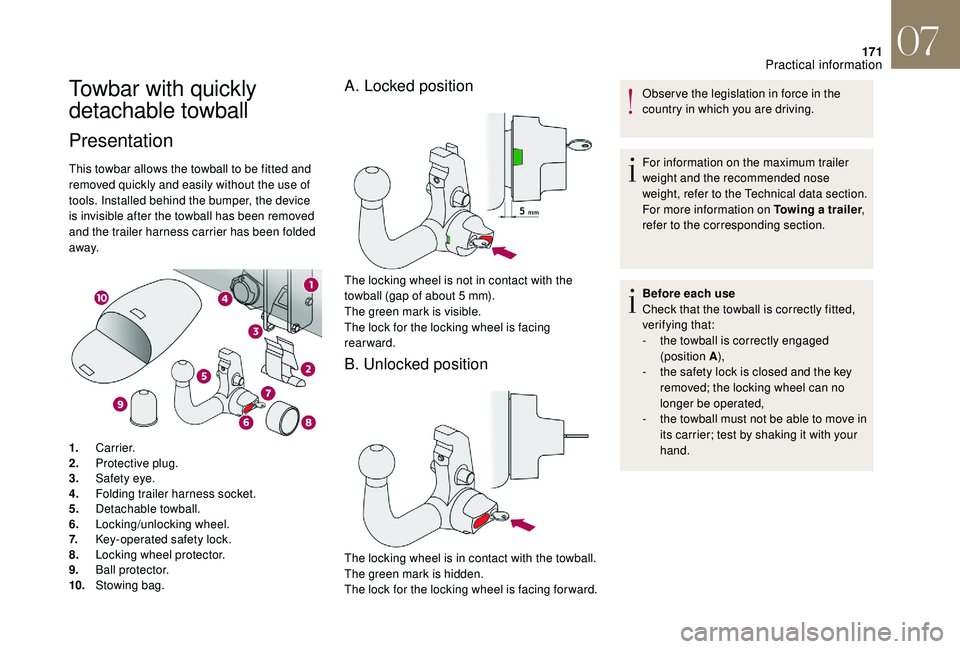
171
Towbar with quickly
detachable towball
Presentation
This towbar allows the towball to be fitted and
removed quickly and easily without the use of
tools. Installed behind the bumper, the device
is invisible after the towball has been removed
and the trailer harness carrier has been folded
away.
1. Carrier.
2. Protective plug.
3. Safety eye.
4. Folding trailer harness socket.
5. Detachable towball.
6. Locking/unlocking wheel.
7. Key-operated safety lock.
8. Locking wheel protector.
9. Ball protector.
10. Stowing bag.
A. Locked position
The locking wheel is not in contact with the
towball (gap of about 5 mm).
The green mark is visible.
The lock for the locking wheel is facing
rearward.
B. Unlocked position
The locking wheel is in contact with the towball.
The green mark is hidden.
The lock for the locking wheel is facing for ward. Obser ve the legislation in force in the
country in which you are driving.
For information on the maximum trailer
weight and the recommended nose
weight, refer to the Technical data section.
For more information on Towing a trailer
,
refer to the corresponding section.
Before each use
Check that the towball is correctly fitted,
verifying that:
-
t
he towball is correctly engaged
(position A ),
-
t
he safety lock is closed and the key
removed; the locking wheel can no
longer be operated,
-
t
he towball must not be able to move in
its carrier; test by shaking it with your
hand.
07
Practical information
Page 174 of 296
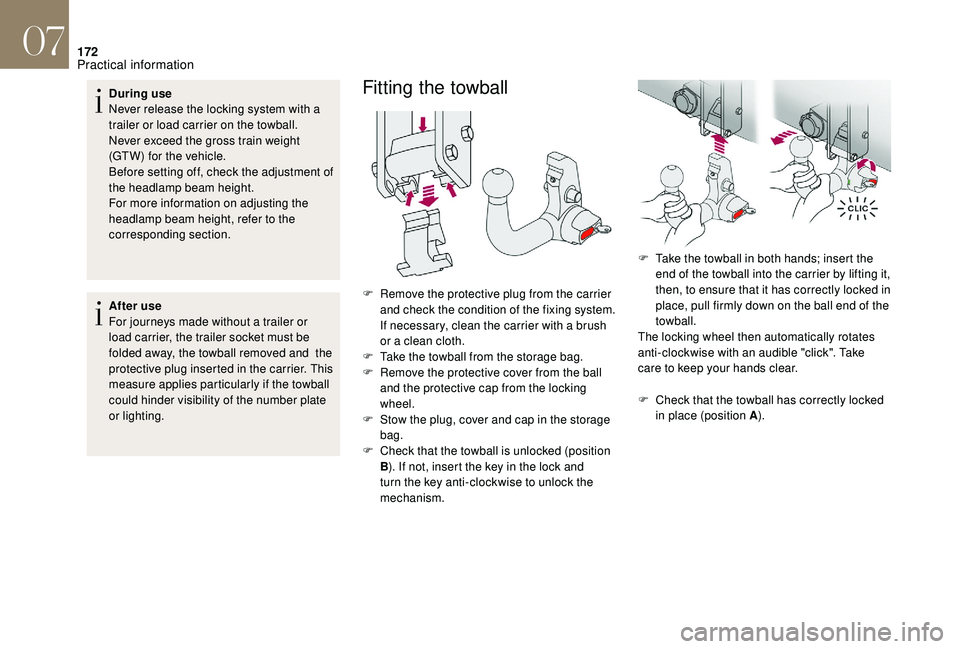
172
During use
Never release the locking system with a
trailer or load carrier on the towball.
Never exceed the gross train weight
(GTW) for the vehicle.
Before setting off, check the adjustment of
the headlamp beam height.
For more information on adjusting the
headlamp beam height, refer to the
corresponding section.
After use
For journeys made without a trailer or
load carrier, the trailer socket must be
folded away, the towball removed and the
protective plug inserted in the carrier. This
measure applies particularly if the towball
could hinder visibility of the number plate
or lighting.Fitting the towball
F Remove the protective plug from the carrier and check the condition of the fixing system.
If necessary, clean the carrier with a brush
or a clean cloth.
F
T
ake the towball from the storage bag.
F
R
emove the protective cover from the ball
and the protective cap from the locking
wheel.
F
S
tow the plug, cover and cap in the storage
bag.
F
C
heck that the towball is unlocked (position
B ). If not, insert the key in the lock and
turn the key anti-clockwise to unlock the
mechanism. F
T
ake the towball in both hands; insert the
end of the towball into the carrier by lifting it,
then, to ensure that it has correctly locked in
place, pull firmly down on the ball end of the
towball.
The locking wheel then automatically rotates
anti-clockwise with an audible "click". Take
care to keep your hands clear.
F
C
heck that the towball has correctly locked
in place (position A ).
07
Practical information
Page 175 of 296

173
F Turn the key clockwise to lock the towball fixing mechanism.
F
A
lways remove the key and keep it in a safe
place.
If the key cannot be turned or removed,
this means that the towball is not fitted
correctly; start the procedure again.
If any locking step fails, start the
procedure again.
In all cases, if the marking remains red, do
not use the towball and contact the dealer
network or a qualified workshop.
F
A
ttach the trailer to the tow ball. F
A ttach the cable on the trailer to the security
eye located on the carrier.
F
L
ower the trailer harness socket carrier
by pulling down the eye visible below the
b u m p e r.
F
R
aise the protective cover on the socket
and connect the trailer plug.
Removing the towball
F Disconnect the trailer wiring harness from the socket on the carrier.
F
D
etach the trailer safety cable from the eye
on the carrier.
F
D
etach the trailer from the towball.
F
R
eturn the trailer harness connector carrier
to the folded position.
07
Practical information
Page 176 of 296
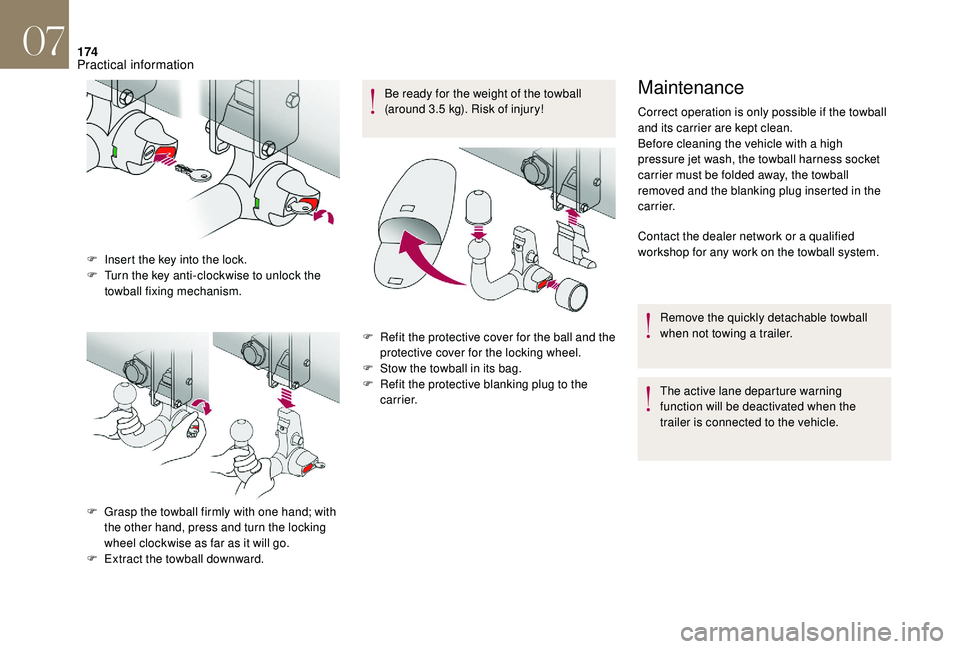
174
F Insert the key into the lock.
F T urn the key anti-clockwise to unlock the
towball fixing mechanism.
F
G
rasp the towball firmly with one hand; with
the other hand, press and turn the locking
wheel
clockwise as far as it will go.
F
E
xtract the towball downward. Be ready for the weight of the towball
(around 3.5 kg). Risk of injury!
F
R
efit the protective cover for the ball and the
protective cover for the locking wheel.
F
S
tow the towball in its bag.
F
R
efit the protective blanking plug to the
c a r r i e r.
Maintenance
Correct operation is only possible if the towball
and its carrier are kept clean.
Before cleaning the vehicle with a high
pressure jet wash, the towball harness socket
carrier must be folded away, the towball
removed and the blanking plug inserted in the
c a r r i e r.
Contact the dealer network or a qualified
workshop for any work on the towball system.
Remove the quickly detachable towball
when not towing a trailer.
The active lane departure warning
function will be deactivated when the
trailer is connected to the vehicle.
07
Practical information